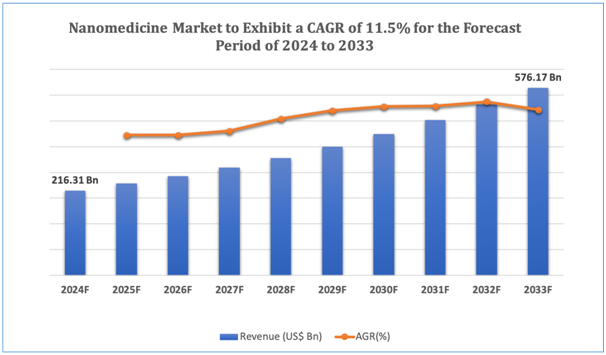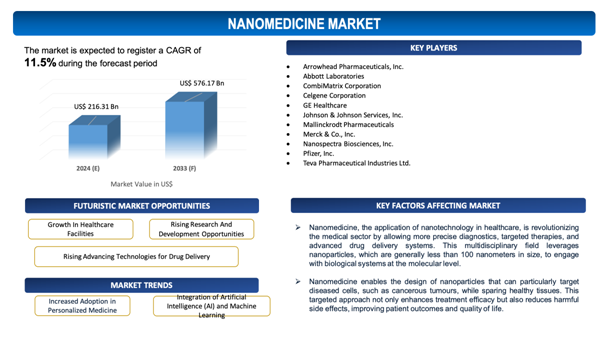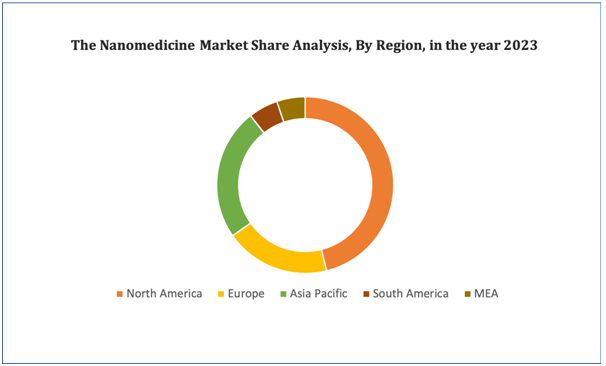Nanomedicine Market Overview
The global nanomedicine market is estimated to be worth over USD 576.17Bn in 2033 and is expected to grow at CAGR of 11.5% during the forecast period (2024-2033).
Nanomedicine, the application of nanotechnology in healthcare, is revolutionizing the medical sector by allowing more precise diagnostics, targeted therapies, and advanced drug delivery systems. This multidisciplinary field leverages nanoparticles, which are generally less than 100 nanometers in size, to engage with biological systems at the molecular level. By manipulating materials at such a small scale, nanomedicine offers advancements in treating complex diseases like neurological conditions, cardiovascular disorders, cancer, and infections, transforming the healthcare outlook in unparalleled ways.
One of the most impactful areas of nanomedicine is targeted drug delivery. Conventional treatments, such as chemotherapy, often affect both healthy and diseased cells, resulting inmajor side effects. Nanomedicine enables the design of nanoparticles that can particularly target diseased cells, such as cancerous tumours, while sparing healthy tissues. This targeted approach not only enhances treatment efficacy but also reduces harmful side effects, improving patient outcomes and quality of life. Nanoparticles can also be engineered to release drugs in response to specific stimuli, such as changes in pH or temperature, further refining the precision of treatments.
In diagnostics, nanomedicine is enabling earlier and more accurate detection of diseases. Nanoscale imaging agents and biosensors can identify biomarkers at remarkably low concentrations, allowing for the detection of conditions like cancer or infectious diseases in their early stages. This early intervention is critical for enhancing survival rates and minimizing the burden of disease on healthcare systems.
In addition, nanomedicine is fuelling advancements in regenerative medicine. Nanomaterials are being used to create scaffolds that support tissue growth, aiding in the repair or regeneration of damaged organs and tissues. This holds great promise for treating degenerative diseases, injuries, and conditions that currently have limited treatment options.
All in all, nanomedicine is reshaping the future of healthcare by offering more personalized, efficient, and less invasive solutions to some of the most pressing medical challenges. As research and development in this field continue to progress, nanomedicine is expected to further revolutionize the diagnosis, treatment, and prevention of a wide range of diseases, improving global healthcare outcomes.
Figure 1. Nanomedicine: Market Size

Get more details on this report - Request Free Sample
Key Market Insights
The global nanomedicine market is experiencingswift growth, fuelled by developments in nanotechnology and its expanding application in healthcare. Latest market insights underscore the growing prevalence of chronic diseases such as cardiovascular disorders, cancer, and neurological conditions, which are accelerating the demand for nanomedicine-based therapies. Nanomedicine provides more precise drug delivery systems, enhanced diagnostics, and advanced treatment methods, making it an attractive solution for addressing complex medical challenges.
Notable developments in the market comprise the incorporation of nanoparticles in drug delivery systems to target specific cells or tissues, improving treatment efficiency while reducing side effects. These innovations are especially impactful in cancer treatment, where nanomedicine is used to deliver chemotherapeutic agents directly to tumors, enhancing outcomes and minimizing damage to healthy cells. In addition, the surge of nanodiagnostics, which utilizes nanoparticles for early disease detection through imaging and biomarker identification, is transforming how diseases are diagnosed and managed.
Novel technologies, such as nanosensors, nano-carriers, and nanoparticle-based imaging agents, are driving innovation in the market. Nano-carriers allowregulated drug release and improved bioavailability, while nanosensors offer enhanced sensitivity for determining diseases at their earliest stages. Along with that, nanomedicine is holding a critical role in the development of regenerative medicine, with nanomaterials being used to repair or regenerate damaged tissues.
As research and development efforts continue, and regulatory approvals for nanomedicine-based therapies increase, the market is anticipated to expand further, with promising applications in infectious diseases, oncology, cardiovascular health, and more.
Market Dynamics
Market Drivers
Rising Advancing Technologies for Drug Delivery
Advancing technologies for drug delivery are a leading market driver for the global nanomedicine market, transforming how medications are administered and enhancing therapeutic outcomes. Nanomedicine leverages nanoscale materials to create highly efficient drug delivery systems that can accurately target diseased cells or tissues, enhancing treatment efficacy while minimizing side effects. Conventional drug delivery methods often result in systemic distribution, affecting both healthy and diseased cells. However, with nanotechnology, drugs can be encapsulated within nanoparticles, designed to specifically target areas such as tumors, inflamed tissues, or specific organs.
These advanced drug delivery systems offer regulated and continued release of therapeutic agents, enhancing the bioavailability and stability of drugs. For instance, in cancer therapy, nanoparticles can deliver chemotherapeutics directly to cancer cells, minimizing the damage to healthy cells and enhancing patient outcomes. In addition, innovations in stimuli-responsive nanoparticles—those that release drugs in response to changes in temperature, pH, or other factors—are further refining precision medicine, ensuring that medications are released exactly where and when they are needed.
As these nanotechnology-driven drug delivery systems continue to evolve, they are accelerating the growth of the nanomedicine market by offering safer, more effective treatment alternatives for a broad range of diseases, from cancer to cardiovascular and neurological conditions.
Market Restraints
With regard to numerous advantages of nanomedicine, the market faces several challenges due to the unique characteristics and requirements associated with these potent pharmaceutical products. Some of the key market challenges include:
- High Development Costs and Complex Manufacturing: The manufacturing of nanomedicine includes sophisticated and costly processes, involving the design, synthesis, and characterization of nanoparticles. These high development costs, coupled with the complexity of manufacturing nanotechnology-based products, pose a majorchallenge for companies, especially smaller players, which may deter market expansion.
- Regulatory and Safety Challenges: Nanomedicine faces stringent regulatory impedimentsowing to the novel properties of nanomaterials. Ensuring the efficacy, safety, and long-term effects of these therapies requires extensive clinical trials and regulatory approvals, which can be time-consuming and expensive. In addition, concerns about potential toxicity and environmental impact of nanoparticles further complicate the approval process, acting as a barrier for market growth.

Get more details on this report - Request Free Sample
Market Opportunity
Growth In Healthcare Facilities
The growth in healthcare facilities globally presents a substantial market opportunity for the global nanomedicine market. As healthcare infrastructure expands, especially in emerging economies, there is a greater demand for advanced medical technologies, comprising nanomedicine-based therapies. Enhanced access to healthcare services enables more patients to benefit from advanced treatments, comprising those involving nanotechnology, which provides more precise drug delivery, improved diagnostics, and targeted therapies.
This expansion in healthcare facilities also encourages the adoption of leading-edge medical technologies, as hospitals and clinics aim to offer avante-garde treatments to meet the growing demand for quality healthcare. With increasing investments in healthcare infrastructure, especially in oncology, cardiovascular care, and diagnostics, nanomedicine’s potential applications are becoming more widespread. In addition, the availability of improved healthcare systems increases opportunities for clinical trials, propelling the development and commercialization of nanomedicine-based products.
As healthcare systems modernize and expand, the global nanomedicine market is set to benefit from higher acceptance, integration, and accessibility, particularly in regions where advanced medical treatments were previously unavailable. This growth in healthcare facilities improves the reach and potential impact of nanomedicine, making it a promising area for future market expansion.
Market Trends
- Increasing Adoption of Personalized Medicine: There is a soaring trend toward personalized medicine in the global nanomedicine market. Nanotechnology allows more accurate targeting of treatments based on an individual’s genetic profile or specific disease characteristics. This move is fuelling the development of nanomedicine-based therapies customized to individual patients, especially in cancer and rare diseases, where tailored treatment plans can substantiallyenhance outcomes.
- Integration of Artificial Intelligence (AI) and Machine Learning: The incorporation of AI and machine learning is revolutionizing nanomedicine, especially in drug discovery, diagnostics, and treatment optimization. AI is being used to design nanoparticles more effectively, predict their interactions with biological systems, and assess complex data from nanodiagnostics. This trend is boosting the development of more effective nanomedicine therapies and allowing faster, more precise decision-making in clinical settings.
Nanomedicine Market: Key Segments
By Application
- Therapeutics
- In-vitro Diagnostics
- Drug Delivery
- In-vivo Imaging
- Implants
By Indication
- Clinical Oncology
- Infectious Diseases
- Clinical Cardiology
- Orthopaedics
- Others
By Molecule Type
- Nanoparticles
- Metal & Metal Oxide Nanoparticles
- Liposomes
- Polymers & Polymer Drug Conjugates
- Hydrogel Nanoparticles
- Dendrimers
- Inorganic Nanoparticles
- Nanoshells
- Nanotubes
- Nanodevices
By Key Geographical Regions
- North America
- Europe
- Asia-Pacific
- Middle East and Africa
- South America
Figure 4. Nanomedicine Market: Distribution by Region

Get more details on this report - Request Free Sample
Nanomedicine Market: Regional Analysis
North America dominated the market with a share of 49.91% in 2022. This expansion is due to the presence of expanding partnerships between businesses working in this area and nanomedicine start-up companies. Furthermore, the region is favoured by the support from governmental authorities combined with rising R&D expenditures. The nation also boasts a sizable number of manufacturing firms with active strategic ventures in the nanomedicine industry.
Leading Nanomedicine Developers
Industry Trends and Global Forecasts, 2023-2035 report features an extensive study of the current market landscape, market size and future opportunities associated with the Nanomedicine market, during the given forecast period. Further, the market report highlights the efforts of several stakeholders engaged in this rapidly emerging segment of the biopharmaceutical industry. Key takeaways of the Nanomedicine market are briefly discussed below.
The report includes the list of players operating in the global Nanomedicine market. Some of the key players include:
- Arrowhead Pharmaceuticals, Inc.
- Abbott Laboratories
- CombiMatrix Corporation
- Celgene Corporation
- GE Healthcare
- Johnson & Johnson Services, Inc.
- Mallinckrodt Pharmaceuticals
- Merck & Co., Inc.
- Nanospectra Biosciences, Inc.
- Pfizer, Inc.
- Teva Pharmaceutical Industries Ltd.
Nanomedicine Market: Key Developments
- In September 2023, Evonik is strengthening its platform of parenteral drug delivery solutions with three new standard PLA-PEG di-block copolymers and a new nanoparticle formulation service using sonication technology. The copolymers (RESOMER® RP d) are especially suited to nanoparticle formation and can be used in a wide range of parenteral drug delivery applications including controlled and sustained release drug products.
Scope of the Report
The market report presents an in-depth analysis of the various firms / organizations that are engaged in this market, across different segments, as defined in the below table:
|
|
Key Report Attributes |
Details |
||
|
|
Base Year |
2023 |
||
|
|
Forecast Period |
2024-2033 |
||
|
|
CAGR (2024-2033) |
11.5% |
||
|
|
Application |
|
||
|
|
Indication |
|
||
|
|
Molecule Type |
|
||
|
|
Key Geographical Regions |
|
||
|
Key Companies Profiled |
|
|
||
